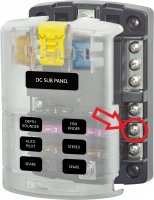captainhook
Jetboaters Captain
- Messages
- 941
- Reaction score
- 745
- Points
- 232
- Location
- Southern Maryland
- Boat Make
- Yamaha
- Year
- 2008
- Boat Model
- Limited
- Boat Length
- 23
I'm installing a Kenwood KAC-M3004 amp to power two more pairs of Polk DB651s. I bought a Blue Sea 5205 6 circuit fuse block, KnuKonceptz 4 gauge power and ground wire, and a bunch of speaker wire. As I'm going to assemble it, I realize there is no way I am going to be able to shove 4 gauge wire under the fuse block circuits circled in the image below. What ring connectors is everyone using in this scenario?






